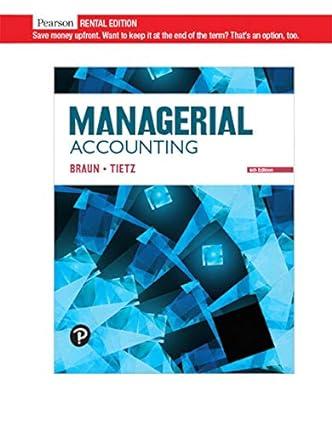Since 2016, the price of coffee has fluctuated. Despite increases and decreases in coffee costs, Starbucks has
Question:
Since 2016, the price of coffee has fluctuated. Despite increases and decreases in coffee costs, Starbucks has only raised the prices of its brewed coffee across the United States over that same period.
In many of the regions in which Starbucks operates, laws have been passed to raise the minimum wage. In addition, the real estate market has recovered in several cities, causing the cost of retail space to increase. Starbucks also covers the full cost of an online degree for its U.S. employees who work at least 20 hours per week.
requirements 1. Would you consider Starbucks to be a service company, a merchandiser, a manufacturer, or some combination thereof? Support your answer with specific examples.
2. Describe the value chain for a cup of coffee at Starbucks. Use your imagination and brainstorm possible costs at each phase of the value chain. Where are the cost increases occurring in that value chain? Where are the cost decreases occurring in the value chain?
3. Think about a Starbucks café in Bellevue, Tennessee, and a cup of coffee served and consumed in that café.
a. What costs would be included in the cost of a cup of coffee served in the café?
Separate these costs into direct materials, direct labor, and overhead costs.
Which type(s) of costs (direct materials, direct labor, or overhead costs) would have increased in the past few years for Starbucks? Which type(s) would have decreased in the past few years?
b. What are the direct costs of a cup of coffee, assuming that the cost object is the Bellevue location? What are the indirect costs of that same cup of coffee for the Bellevue location?
c. Assume now that the cost object is the Starbucks corporation itself. What costs of that cup of coffee will now be reclassified as direct (as compared to using the Bellevue location as the cost object)?
4. Now think about a Starbucks café in Bellevue, Tennessee, and a pound of bagged ground coffee sold in that café (assume that the beans are ground in the store at the time of sale).
a. What costs are included in the cost of a pound of bagged ground coffee sold at the Bellevue location? Separate these costs into direct materials, direct labor, and overhead costs.
b. What are the direct costs of a pound of bagged ground coffee (to be sold to consumers), assuming that the cost object is the Bellevue location? What are the indirect costs of that same pound of bagged ground coffee for the Bellevue location?
c. Assume now that the cost object is the Starbucks corporation itself. What costs of that bagged ground coffee will now be reclassified as direct (as compared to using the Bellevue location as the cost object)?
Step by Step Answer:






